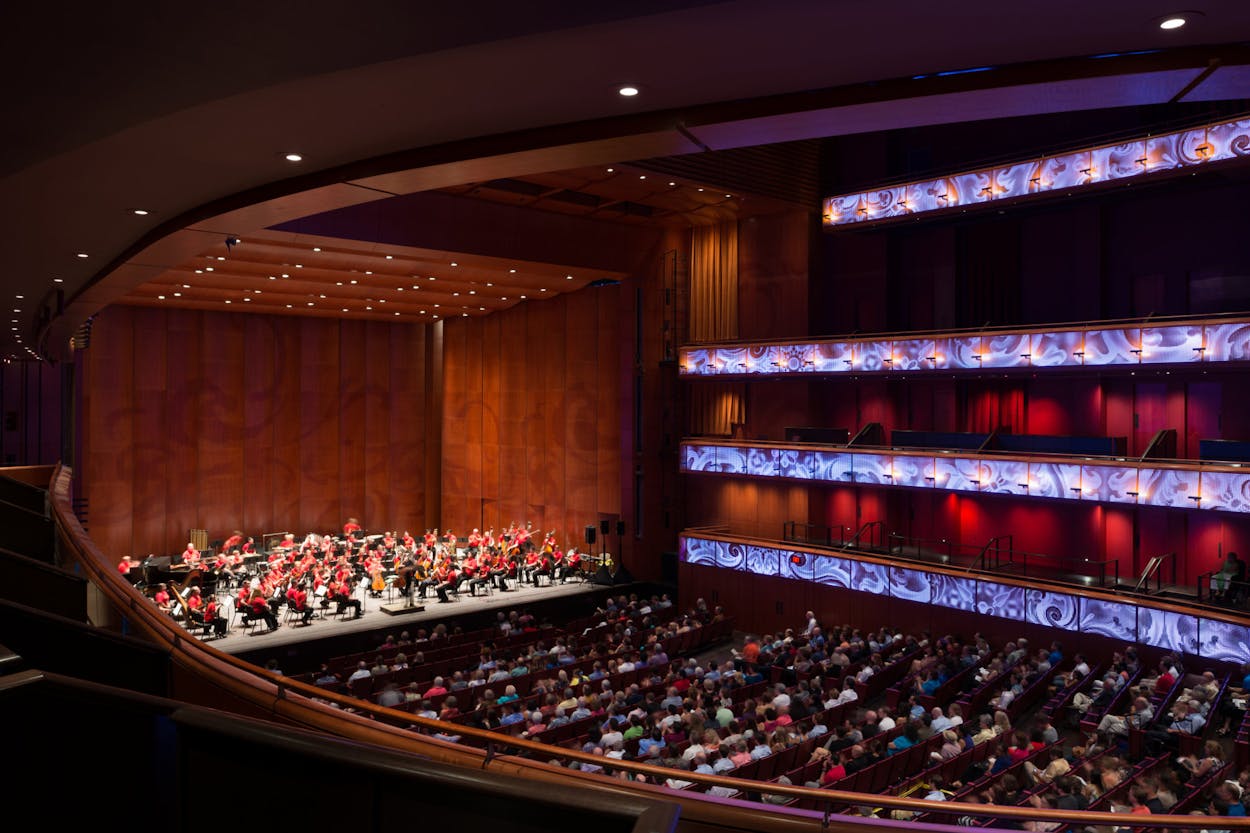SAN ANTONIO — With the press of a button, the H-E-B Performance Hall in the Tobin Center for the Performing Arts can be transformed from a concert venue with traditional raked seating to a flat-floored dance hall. A mechanized “flexible floor” system elevates the seats on platforms, flips the platforms over, and then lowers them to create a flat, stained maple floor. The process takes 23 minutes.
Such a high-tech interior is hard to imagine within the Spanish colonial facade of an arena that originally opened in 1926 as Municipal Auditorium. The flexible floor is “the only one of that type,” said Mark Reddington, a partner at LMN Architects and the Tobin Center’s lead designer.
“We could do a corporate breakfast or lunch, push the button, the seats pop back up, and do a concert that night,” said Mike Fresher, the center’s president and chief executive.
The Tobin Center spent seven years in development and opened on Sept. 4 with an evening of performances from the city’s ballet, symphony and opera companies. “San Antonio is the largest city in the country without a performing arts center,” Fresher said. “Until now.”
The building was repurposed through an unusual public-private partnership. “I’ve been told it’s never been done in the history of San Antonio,” said J. Bruce Bugg Jr., founder and chairman of the Bexar County Performing Arts Center Foundation.
Voters of Bexar County approved $100 million for the project in May 2008, and the next month, the San Antonio City Council transferred ownership of Municipal Auditorium and other properties, valued at $41 million, to the foundation. County commissioners allocated $8 million dedicated to the development of the River Walk Plaza, an outdoor event space that is part of the center, and Bugg’s team raised $54 million in private donations.
The foundation gave architects three challenges: to preserve Municipal Auditorium’s iconic limestone facade, to install top-notch acoustics and to integrate the San Antonio River into the facility, which sits on the River Walk.
The architects, Marmon Mok of San Antonio and LMN Architects of Seattle, met the challenges while including elements like the flexible floor and an automated sound-absorbing curtain system.
The building’s two original rotundas, at the east and west corners of the main entrance, were kept, while the interior was updated. “Do you remember in the 1980s when people would take carpet and glue it on the wall?” Bugg said, recalling what the rotundas looked like when Municipal Auditorium changed hands in 2008. “We didn’t preserve that décor, let me just put it that way.”
The Tobin Center is outfitted with color-changing LED lights, which decorate the aluminum veil that adorns the building’s exterior and illuminate the perforated wood panels in the H-E-B Performance Hall.
When the floor is not flat, the hall seats 1,759, with no seat more than 143 feet from the stage. “I think what the hall creates is this synergy between the audience and the stage,” said Sebastian Lang-Lessing, the San Antonio Symphony’s conductor.
“It is really the first time in the history of the San Antonio Symphony that we have a hall with the proper acoustics,” Lang-Lessing said, “but at the venue where the orchestra was founded 75 years ago.”
In addition to the Performance Hall, two other spaces are available for the 10 artistic groups that call the Tobin Center home — the Carlos Alvarez Studio Theater, which can seat 250 to 350 people, and the River Walk Plaza, which can seat 600 and accommodate 1,600 people in all.
Originally a loading dock for Municipal Auditorium, the River Walk Plaza has a 32-by-18-foot video screen that can be used to digitally display an artist playing in the plaza, simulcast an event inside the Tobin Center and screen films on movie nights. Opening up to the River Walk, the plaza is a community space, though it can be cordoned off for ticket-only events.
“I think the Tobin Center is going to be a huge economic generator for San Antonio,” Bugg said. “Not only will it support the creative economy that already exists, but it’s going to augment the opportunities to bring other activities to San Antonio.”
Graham Weston, a founder of the web hosting company Rackspace and a Tobin Center donor, agreed. “Most recruiters these days are selling two products: their company and their city,” Weston wrote by email. “Especially if you are in the technology sector, people want to move to a city that has unique cultural options.”
The Tobin Center is already attracting big-name acts — Lynyrd Skynyrd, Jason Mraz and Trace Adkins all played on the first weekend — and 444 events were booked from Sept. 4 and June 30, 2015.
“San Antonio is still searching a bit for where they fit in the cultural landscape that is Texas,” Fresher, the Tobin Center’s chief executive, said. “There’s much more to do before we can say where we are with the cultural arts in San Antonio, but building a world-class, $203 million building is certainly a good start.”
Recruiting Paul McCartney to play the opening benefit on Oct. 1 was, too. “McCartney in a 1,750 seat hall,” Fresher said. “It’s outrageous.”






